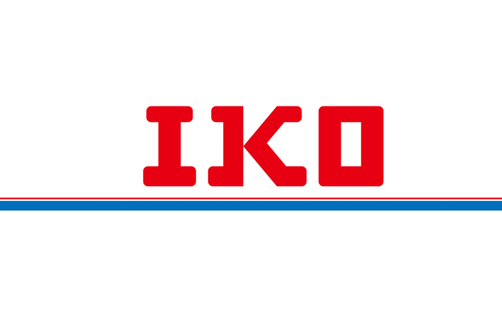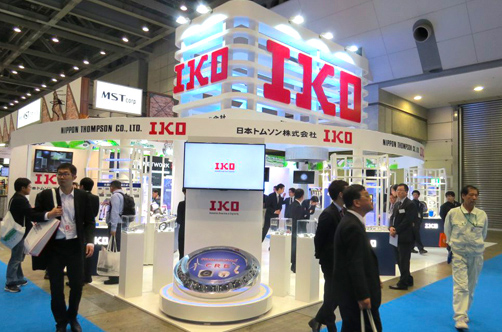
Sustainability ESG Management: Social Issues / Human Capital
Our Approach to Human Resources Strategy
Our Group’s values
Since its founding, Nippon Thompson has operated its business with a philosophy that values people and that “a company depends on its people.” Management that values people is management that enhances the sense of value of employees and leads to providing new value that satisfies customers. The first step is to ensure that our employees are healthy and can work with peace of mind. The next step is being able to work energetically in a well-ventilated environment. We are also working to create an environment in which each employee can act for the benefit of society and our customers and realize their potential.
Human resources strategy for IKO VISION 2030
In order to improve employee value, Nippon Thompson has now compiled its vision for people and the organization into IKO VISION 2030. In this initiative, we have positioned “human resource development,” “appropriate placement of personnel,” and “diversity” as the three pillars of our human resources strategy, and declared that we will reform various personnel systems in order to become a professional group that acts for the happiness of people and society, and realizes solutions and its own dreams and aspirations.
The driving force behind the first goal, “human resource development,” is that it is essential for us to continue to be a company that is trusted and relied upon by society and our customers. The IKO spirit is supported by our sincere and earnest corporate culture and human resources (human capital). By fostering a culture in which employees and executives, and subordinates and superiors, are close to each other and can exchange frank opinions, and embodying this spirit, we will revitalize people and organizations.
The second point, “appropriate placement of personnel,” is premised on placing the necessary number of people in the necessary places based on business strategy, but it is also important to place personnel according to the characteristics of each individual. However, to determine suitability, objective numerical data rather than subjective values is essential. To achieve this goal, we are currently in the process of introducing an integrated human resources system. By digitizing each employee's ability tests, acquired qualifications, past experience, and project history, and introducing a talent management system, we will be able to visualize the tasks that employees are good at and those that they are not good at.
The third point is “diversity.” When we talk about diversity, we tend to focus only on the differences between people; however, I think that if we do not have some common values, it will be difficult to work together as a team. One important element in making the most of diversity is creating an environment that encourages close communication within the team. Because we have a diverse range of people, close communication is essential. So, in recent years the HR Department has been holding repeated dialogues with employees, from new recruits and regular employees to management and executive staff. As the HR Department, we will continue to place importance on dialogue with employees, and will also implement measures to foster close communication within each department.

Human Resource Development
Current state of human resource development
We are committed to human resource development from a medium- to long-term perspective with high retention as our strength, and we are working on measures to enable each employee to gain various experiences based on our human resource development philosophy that “there is no better way to develop human resources than through experience.”
Specifically, OJT is the pillar of our human resource development. We encourage steady growth through an education system that carefully attends to each individual at each workplace, which embodies our sincere and earnest corporate culture. In addition, the nature of our business, which places the highest priority on “solving issues faced by society and customers,” is a characteristic of the Company. Each and every employee accelerates the rate of growth through overcoming daily challenges. In addition, we strive to develop leaders by providing various types of Off-JT training for different levels of employees, and also conduct practical training activities for each department.
We also focus on supporting self-development from the perspective of employee “autonomy.” We not only have an incentive system for public qualifications, but also encourage the acquisition of national qualifications such as technical skills tests, which results in the creation of many qualified employees every year. This helps in cultivating our ability to propose solutions to society and customer issues and to respond to technical issues.
Developing and producing the next generation of leaders
While we are steadily implementing these various training measures, we believe that there are issues regarding the organic linkage of these measures with human resource management as a whole. In light of this, the IKO Medium- Term Business Plan 2026 aims to strengthen the human resource development function with the aim of fostering and producing “next-generation leaders” from a more medium- to long-term and global perspective. Specifically, we will strive to develop strategic personnel rotations and global human resource development measures based on the definition of “the type of human resources we seek,” as well as DX human resources capable of creating new value through fundamental reform of operations.
| Indicators | FY2023 | FY2024 | FY2025 |
|---|---|---|---|
| Percentage of employees receiving training by job level [%] | 13.6 | 12.6 | 9.5 |
| Number of national qualifications holders [persons] | 1,453 | 1,513 | 1,528 |
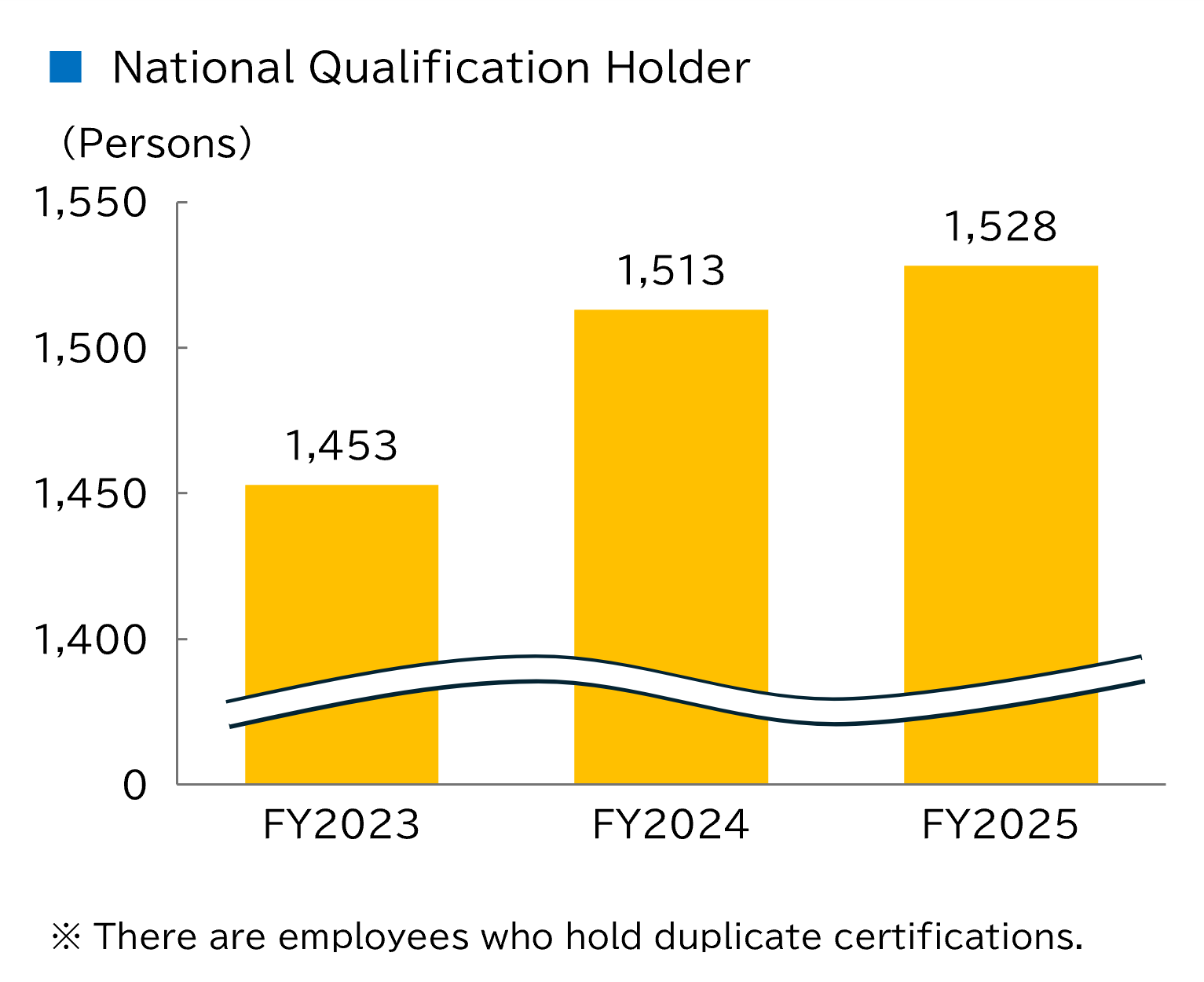
Appropriate placement of personnel
Talent management
In terms of human capital initiatives, we place great importance on developing the capabilities of each employee, while also positioning personnel allocation with the aim of maximizing organizational functions and strengthening future growth areas as key issues. Since we have employees with diverse attributes, we will maximize organizational functions by building a human resource portfolio based on a balance of human resources. We believe that in order to achieve this, it is essential to implement precise talent management, and we are currently progressing with a project to introduce an integrated human resources system with an eye toward introducing talent management in the future. The system is expected to be operational by 2025. The introduction of the system will not only lay the foundation for talent management, but will also improve the strategic functions of the HR Department by radically streamlining the HR Department’s operations.
Talent acquisition policy
In addition to placing the best possible resources among current employees, we also place importance on strategies to acquire new talent in light of the declining birthrate, aging population, and shrinking labor force. Our hiring policy is to be conscious of the diversity of our human resources portfolio in terms of hiring style, skills, age, gender, etc. Among these, we place particular emphasis on the hiring of new graduates oriented toward medium to long-term human resources development, leveraging our strength in high retention. In our recruiting activities, we are strongly aware of the compatibility with the human resource requirements we seek and the empathy with our philosophy. We emphasize emotional matching in which both the Company and the job seeker feel a desire to “work together.” We also strive to prevent job seekers from declining offers or leaving early by creating opportunities to come into contact with them using a variety of media and fostering a desire to join the Company through thorough mutual understanding during the selection process. Through these initiatives, we are able to steadily secure talent even amid intensifying competition among companies to attract talent. We will continue to work towards acquiring the talent that will lead the Company into the future.
| Indicators | FY2023 | FY2024 | FY2025 |
|---|---|---|---|
| Rate of employees leaving for personal reasons [%] | 2.4 | 2.0 | 1.7 |
| Turnover rate within three years of employment [%] | 4.9 | 3.8 | 11.5 |
Diversity
Diversity & Inclusion (D&I)
In order to respond to the diversifying needs of society, we consider it a key issue to secure diversity in our human resources. We are working to develop human resources by providing fair opportunities for skill development to all human resources regardless of gender, age, nationality, work experience, etc., and to support their individual work styles. In particular, we focus on preventing career discontinuation due to childcare, and support the balance between childcare and work. We work closely with the departments that have employees taking childcare leave and the HR Department to address individual concerns as much as possible.
| Indicators | March 31, 2023 | March 31, 2024 | March 31, 2025 |
|---|---|---|---|
| Percentage of female employees [%] | 12.8 | 13.3 | 14.5 |
| Percentage of female supervisory positions [%] | 11.9 | 13.1 | 13.2 |
| Percentage of female managers [%] | 1.5 | 1.9 | 2.8 |
| Percentage of new female graduates hired [%] | 25.8 | 30.8 | 28.6 |
| Indicators | FY2023 | FY2024 | FY2025 |
|---|---|---|---|
| Wage gap between male and female employees (All employees) [%] | 51.6 | 52.5 | 54.6 |
| Wage gap between male and female employees (Regular employees) [%] | 79.4 | 79.8 | 80.6 |
| Wage gap between male and female employees (Non-regular employees) [%] | 70.7 | 66.5 | 64.8 |
| Male childcare leave utilization rate [%] | 51.9 | 65.5 | 75.0 |
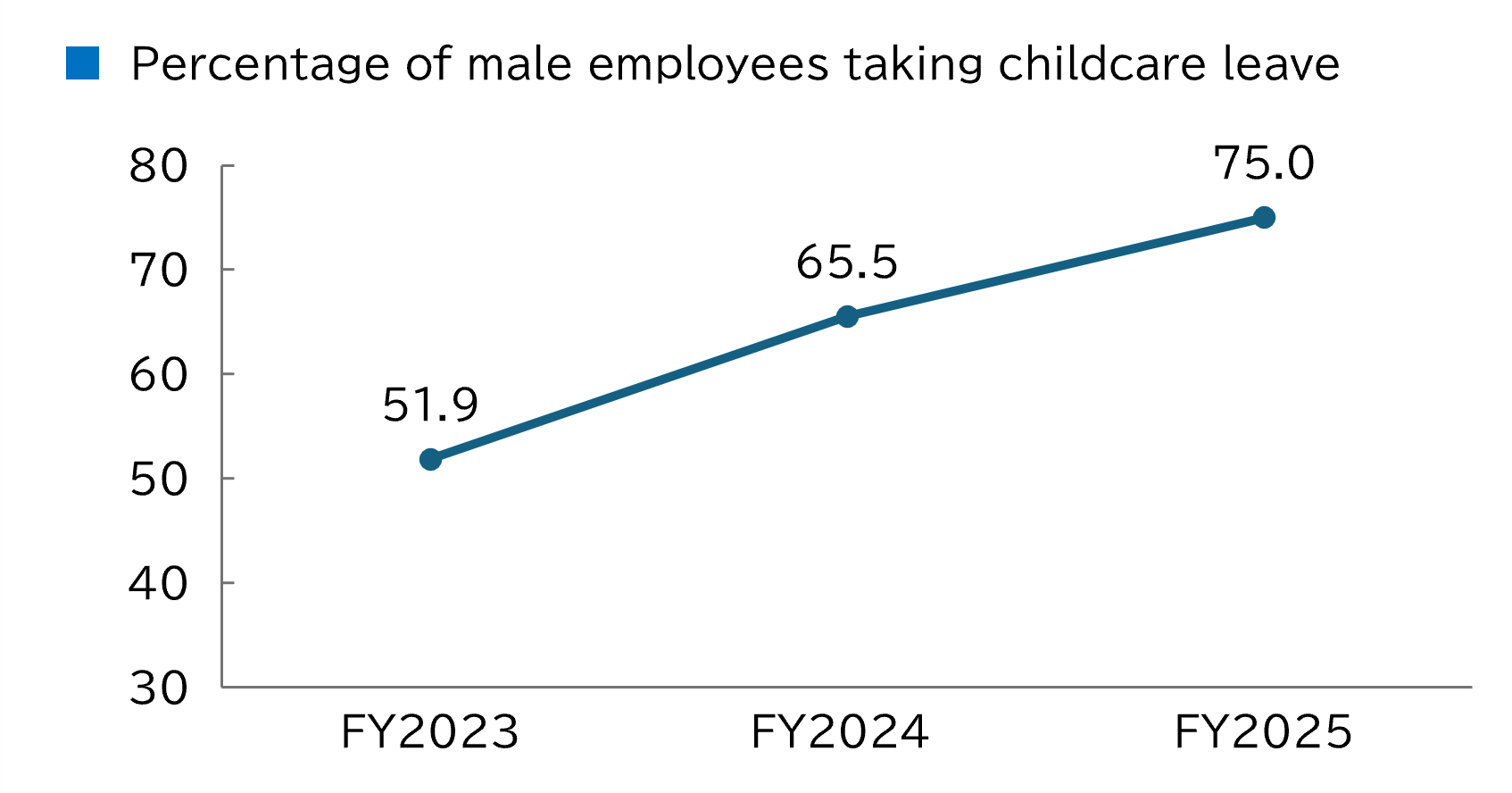
Engagement
The Company's human resource goal regarding diversity is not limited to D&I, but is positioned as “a corporate culture that fosters mutual recognition of value regardless of nationality, gender, or age, and a group of talent in which all employees feel motivated and are embracing change.” We are making progress with our initiatives to build a collaborative system that transcends departments and nationalities and to improve engagement.
We consider engagement to be a particularly important issue for the Company. The Company aims to develop human resources from a medium- to long-term perspective. We believe that an environment in which employees can work with peace of mind is essential to achieving this goal. In order to foster a sense of security among employees, we place great importance on employee benefits. In order to increase employee satisfaction, we work in cooperation with the labor union, with whom we maintain a good relationship, to improve various systems, such as providing housing and meal assistance. In addition, we are working to improve employee engagement by fostering individual growth aspirations and realizing career plans through interviews based on a self-assessment system and a target management system. In addition to these efforts, we will conduct engagement measurement in the future to understand our actual situation and to further improve the value of our human resources and organizational strength.
| Indicators | FY2023 | FY2024 | FY2025 |
|---|---|---|---|
| Percentage of annual paid leave taken [%] | 68.0 | 73.4 | 76.8 |
| Average overtime hours [H:M] | 13:15 | 9:31 | 8:25 |
| Occupational accident frequency rate [%] | 1.195 | 0.413 | 0.400 |
| Occupational accident severity rate [%] | 0.001 | 0.001 | 0.001 |
Metrics and Targets related to human capital

1. Plan period
April 1, 2025 to March 31, 2030
2. Metrics and targets related to diversity-inclusive talent development policies
[Metrics] The percentage of female employees among all full-time hires and the number of female employees in managerial positions and above
[Target 1] Steadily increase the percentage of women among all full–time hires to 20% or more
From April 2025: Hold company information sessions or internships that give priority to women at least twice a year.
From April 2026: Conduct proactive publicity activities for job seekers to promote the workplace as one where women can thrive.
[Target 2] Increase the number of women in management positions to more than five times the number in March 2022 (approximately 1.7 times the number in March 2025).
From April 2025: Exchange opinions about women's activities for management.
From April 2026: Review the training curriculum for developing managers.
From April 2027: Provide training for women who are candidates for managers.
From April 2028: Conduct interviews about career plans for women who are candidates for managers.
3. Metrics and targets related to internal environment improvement policies
[Metrics] Annual paid leave utilization rate and childcare leave utilization rates for men and women
[Target 1] Maintain the annual paid leave utilization rate at a sustained 70% or higher for all employees, including fixed-term contract workers.
From April 2025: Communicate to managers to promote planned leave-taking.
From July 2025: Conduct awareness activities in the company newsletter to encourage the planned use of annual paid leave.
From April 2026: Continue the above initiatives.
[Target 2] Achieve childcare leave utilization rates of 85% or higher for both men and women.
From July 2025: Publicize the company's childcare leave and other support systems in the company newsletter.
From September 2025: Revise the materials outlining the company’s childcare leave and other systems, and inform employees about them again.
From March 2026: Confirm the status of acquisition of childcare leave, etc., and introduce examples of such acquisition to employees.
From April 2026: Continue the above efforts.
Implemented systems

| Support name | Contents |
|---|---|
| Infant care leave system | Can be used up until a child reaches 2 years old. |
| Reduced working hours system for childcare | Work can be shortened up to two hours a day up until the end of March of a child’s third year of elementary school. |
| Childcare leave system | Childcare leave for when a pre-school-age child is sick or injured. Up to 5 days a year for 1 child and up to 10 days for 2 or more children. Can be used in half-day units. |
| Family care absence system | Up to 186 days can be used for one family member. |
| Reduced working hours system for family care | Working hours can be shortened up to two hours a day for one family member up to two times within a period of three years. |
| Family care leave system | Up to 5 days a year for 1 family member and up to 10 days for 2 or more family members. Can be used in half-day units. |
External evaluation
Certified as a “Seki City Approved Workplace for Women”
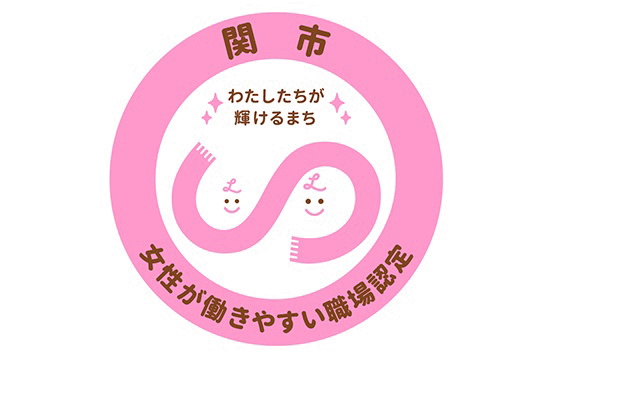
NIPPON THOMPSON’s main factory at the Gifu Factory complex was certified as a “Seki City Approved Workplace for Women” by the Seki City Hall. This indicates that the Company meets 13 specific conditions including preparing and stipulating rules for child/nursing care, maternal health management for female employees, and protection for mothers.
At the Gifu Factory complex, there are currently around 500 female employees. We will make efforts to improve the environment so that employees who are raising children receive consideration at each workplace, and make it easy for them to use leave for school events and when children are sick.
